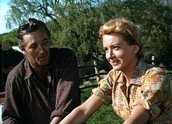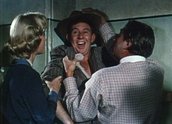


The Sundowners (1960)
Synopsis
At the end of the 1920s, Paddy Carmody (Robert Mitchum) and his wife Ida (Deborah Kerr) have been living on the road as drovers for 16 years. Their son Sean (Michael Anderson Junior) wonders what it would be like to have a house instead of a wagon to sleep in, but his father can’t see the need. As long as there are sheep to move and new pubs to explore, he’s happy. When they pick up a new mob of sheep in the Snowy Mountains, Ida hatches a secret plan to save a down payment for a farm near Jindabyne. A bushfire on the road almost engulfs Paddy and their curious new stockman, Rupert Venneker (Peter Ustinov), an English 'remittance man’. At the end of this drive, Ida persuades Paddy to sign on as a shearer at an outback station. He hates being tied down but the money is good and the contractor Quinlan (Chips Rafferty) has jobs for them all. Ida becomes the cook after the shearers taste her food. The perennial bachelor Rupert pursues the lively Mrs Firth (Glynis Johns), owner of the Pastoral Hotel. Ida becomes friends with Jean Halstead (Dina Merrill), the lonely wife of the station owner. Both women become midwife to Liz Brown (Lola Brooks), the wife of one of the shearers, Bluey Brown (John Meillon), as she prepares for their first baby.
Paddy becomes restless after a few weeks of shearing, missing the life on the road. Emotions boil over when the men arrive back from town drunk, as Liz goes into labour. The shearing contract ends and the Carmodys are about to leave, when Paddy wins a racehorse in a two-up game. Ida persuades him to return to the mountains, where she reveals her plan – to buy the farm they saw before. Paddy loses all of their money that night in another game. The next day Sean rides the racehorse to a thrilling win in a local derby. Paddy offers to buy the farm with the prize money, but Ida decides it would be wrong. Some day, she says, but not yet. They return to the open road.
Curator’s notes
The Sundowners is one of the most entertaining and credible films made by international interests in Australia during the long period of stagnation in the local industry in the 1950s. Apart from the prolific Lee Robinson and the indomitable Charles Chauvel, there were very few local features made by Australian directors during these years. British studios had been active here but Hollywood was traditionally wary about shooting offshore. The Sundowners was an internationally-known Australian book, by the then relatively new author Jon Cleary, but it was by no means certain that it would be filmed in Australia. In his autobiography, the director Fred Zinnemann writes, 'The studio quite naturally assumed that the whole thing could be shot close to home – Arizona could easily double for the outback … There was consternation when it turned out that I wanted to shoot in Australia’. Zinnemann says that Jack Warner, head of Warner Bros Studios, agreed because Zinnemann had just had a big success with The Nun’s Story (1959), which was shot partly in Africa.
Cleary’s novel was written while he was working as an Australian journalist in New York. It came out there in 1951 and was an enormous success, eventually selling three million copies – although it was slow to take off in Australia. Dorothy Hammerstein, the Tasmanian-born wife of the Broadway composer, Oscar Hammerstein, gave Zinnemann a copy in 1958. He bought the rights then sold them to Warner Bros. At least three writers worked on the script, including Jon Cleary. Zinnemann says Cleary came in at the end to put back much of the rich Australian dialogue that Zinnemann felt had been lost in earlier drafts. In the introduction to the 2002 edition of the book, Cleary wrote that Ida and Paddy Carmody are based on his own mother and father. 'My father had led an adventurous life. He had run away from home at 15 and gone to Queensland and worked as a tar-boy in shearing teams. He then became a drover, then a professional boxer, then a lightning sketch artist around the bush music halls, then back to droving. He had told me stories of his life when I had been a kid…’.
The casting of Mitchum and Kerr was controversial, but Hollywood would probably not have made the movie without big stars. There were few Australian actors of international standing at the time. Zinnemann had used Peter Finch in The Nun’s Story (1959), but he was not yet a star in the same league as Robert Mitchum. The accents of both Mitchum and Kerr, though less than true blue, are passably accurate – and far better than many people in Australia would have expected. In any case, the two actors work well as a couple, and they are a large part of the film’s success. The role matches Mitchum’s natural style as a relaxed and intuitive screen presence: he seems to have understood Paddy Carmody’s wanderlust implicitly. Deborah Kerr’s performance is also completely credible. She may be too beautiful for the role but she makes Ida seem like a down-to-earth character who would follow Paddy anywhere. It may have helped that these two actors had worked together successfully before – in Heaven Knows, Mr Allison (1957), made three years earlier.
The Sundowners is also remarkable for the number of Australian actors it showcases. John Meillon had only previously been seen in On the Beach (1959). The Sundowners featured Leonard Teale, Gerry Duggan and an uncredited Ray Barrett. The shearing scenes are extremely vivid, and may have had a strong influence on similar scenes in Sunday Too Far Away (1975), shot 15 years later.
- Overview
- Curator’s notes
- Video 3 clips
- Principal credits
- Find a copy
- Comments 1
- Map
- Add your review



